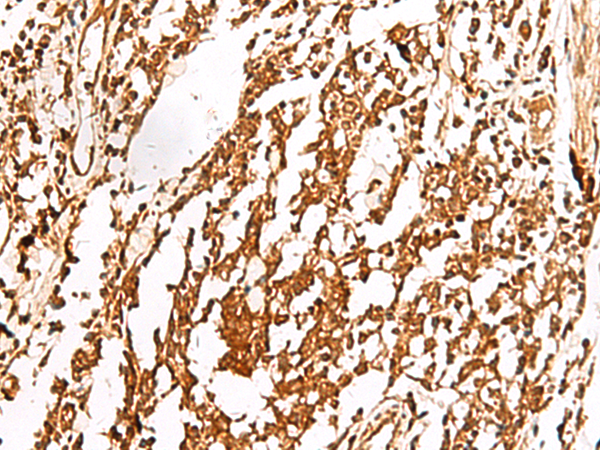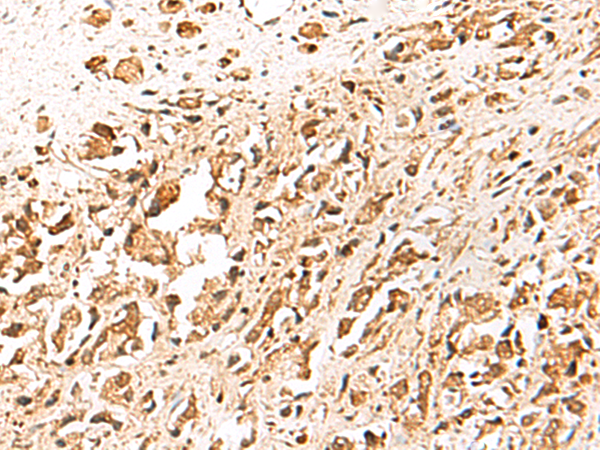


| WB | 咨询技术 | Human,Mouse,Rat |
| IF | 咨询技术 | Human,Mouse,Rat |
| IHC | 1/25-1/100 | Human,Mouse,Rat |
| ICC | 技术咨询 | Human,Mouse,Rat |
| FCM | 咨询技术 | Human,Mouse,Rat |
| Elisa | 1/5000-1/10000 | Human,Mouse,Rat |
| Aliases | TRF; PIN2; TRF1; TRBF1; t-TRF1; hTRF1-AS |
| WB Predicted band size | 50 kDa |
| Host/Isotype | Rabbit IgG |
| Antibody Type | Primary antibody |
| Storage | Store at 4°C short term. Aliquot and store at -20°C long term. Avoid freeze/thaw cycles. |
| Species Reactivity | Human, Mouse |
| Immunogen | Fusion protein of human TERF1 |
| Formulation | Purified antibody in PBS with 0.05% sodium azide and 50% glycerol. |
+ +
以下是关于TERF1(TRF1)抗体的3篇参考文献及其摘要概括:
1. **文献名称**:*"TRF1 is a stem cell-specific telomeric protein in human epidermis"*
**作者**:Deng, Z., et al.
**摘要**:该研究利用TRF1抗体通过免疫荧光和染色质免疫沉淀(ChIP)技术,揭示了TRF1在表皮干细胞端粒保护中的特异性作用,证明其与端粒长度维持及干细胞衰老相关。
2. **文献名称**:*"Antibody-based analysis of shelterin complex dynamics at telomeres"*
**作者**:Takai, K.K., et al.
**摘要**:作者开发了一种高特异性的TRF1抗体,结合超分辨率显微镜技术,解析了庇护蛋白复合体(包括TRF1)在端粒处的动态组装过程,为端粒结构研究提供了新工具。
3. **文献名称**:*"TRF1 dysfunction induces nuclear reorganization in Hutchinson-Gilford progeria syndrome"*
**作者**:Aguado, J., et al.
**摘要**:通过Western blot和免疫细胞化学(使用TRF1抗体),研究发现早衰症患者细胞中TRF1表达异常,导致端粒结构紊乱和核膜缺陷,提示TRF1在核稳定性中的关键角色。
---
**注**:TERF1(TRF1)抗体常用于端粒相关机制研究,上述文献示例聚焦于抗体在蛋白质定位、复合体分析及疾病机制中的典型应用。实际引用时建议通过PubMed或Google Scholar以“TRF1 antibody” + 研究领域(如“telomere”“cancer”“aging”)筛选最新或高影响力论文。
The TERF1 antibody targets TERF1 (Telomeric Repeat Binding Factor 1), a critical protein involved in telomere maintenance. TERF1. also known as TRF1. is a core component of the shelterin complex, which protects chromosome ends by forming a protective cap at telomeres. It binds directly to double-stranded telomeric DNA repeats (TTAGGG)n, facilitating telomere structure stabilization and regulating telomere length by recruiting telomerase-inhibiting factors. Dysregulation of TERF1 is linked to genomic instability, premature aging, and cancer progression, as altered telomere dynamics can trigger DNA damage responses or uncontrolled cell proliferation.
TERF1 antibodies are widely used in research to study telomere biology, cellular senescence, and oncogenesis. They enable detection of TERF1 expression via techniques like Western blotting, immunofluorescence, and chromatin immunoprecipitation (ChIP). Such studies help elucidate TERF1's role in diseases, including its interaction with other shelterin proteins (e.g., POT1. TIN2) and its antagonistic relationship with TERF2. Commercial TERF1 antibodies are typically validated for specificity using knockout cell lines or siRNA knockdown. Research applications span aging models, cancer therapeutics (e.g., telomerase inhibitors), and stem cell studies, where telomere integrity is crucial.
×